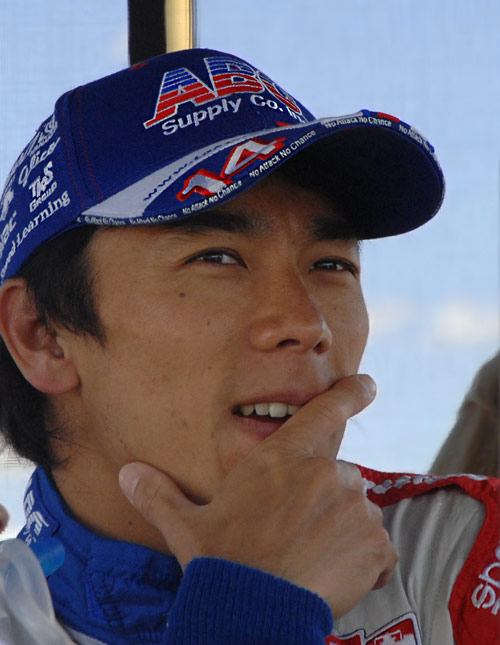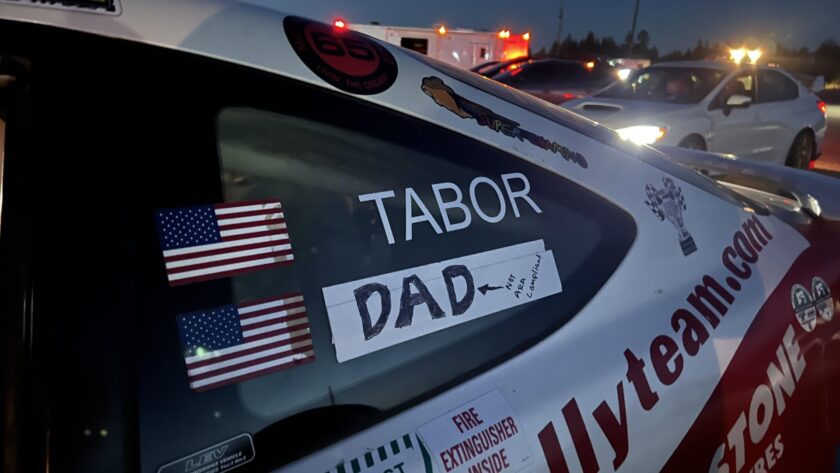I don’t think you’ll find anyone who watched today’s Itaipava Sao Paulo Indy 300 that didn’t think it was one of the best IndyCar races in a very long time. What you will find is a lot of controversy over A.J. Foyt Racing’s Takuma Sato and his driving style in the final laps of the race. While defending his position first against Sarah Fisher Hartman Racing’s Josef Newgarden and finally Andretti Autosport’s James Hinchcliffe, it appeared to many that he actively blocked and chopped in front of his competitors. To others, it seemed that he merely drove a defensive line and it was fair play by all. Here’s the video of Sato and Hinchcliffe making their way down the backstretch and through the T11 hairpin for the final time. Make your own decision.
[youtube_sc url=http://youtu.be/otVvb1oM7rE]
So what do you think? Fair play? Blown call? Here’s what some of the OP staff think of the situation. Let us know what you think in the comments section below.
Shaun Pechin
First off, what a race!! Congrats to Hinch! What we seen out of Sato was fair play in my book. The line was simply defensive and he wasn’t weaving all over the place trying to stop Hinch from getting around. He chose the line that made it most difficult for the chase car to get around. This was a race for the win and I would have been disappointed in Sato had he not made every effort to win. Unfortunately for Sato, his Firestone reds were spent and he could not keep grip under braking and Hinch used RACECRAFT to make the pass. For the first time in a couple years, the IndyCar drivers are proving they can police themselves and put on a great show. I think Beaux did a great job letting them race and it proved to be the best result for the fans, the show, and most importantly the racing. A rare opportunity where all the various elements were satisfied in this generation of P2P, DRS, and other overtaking gimmicks.
Mike Whitesell
I think it is fair to say that Mr. Sato has learned a few lessons from a certain gentleman driver who squeezed him down to the white line at Indy last year. I don’t think there is any question that Sato is guilty of breaking IndyCar’s blocking rules. He clearly came over on Newgarden in response to Joseph diving for the inside. He similarly gave a little juke to Hinch on his passing attempts but not as much of a “block” as he gave Joseph. What really has to be explored is why IndyCar didn’t call him on it. Would race control have taken a firmer stance if Takuma was throwing these blocks earlier in the race? And how will race control look if they start calling blocking at Detroit after letting Takuma slide this time? Will they argue that it was the closing laps, so they didn’t want to make the call? If so, then that is a bit to close for me to the “Have at it boys!” directive that reigns over US tin top racing.
IndyCar’s blocking rule is different from everybody else in the world of professional motorsport. NASCAR may have one, but they haven’t taken it down from the mantle to even dust it in decades. F1 has strengthened their stance on blocking, but it doesn’t come close to IndyCar’s rules that are written favorably for the following car to get the advantage. But at least IndyCar has backed off of the travesty that forced the lead car to follow the race line at all times, thus hanging them out to dry in the outside lane (or a smoking heap of carbon fiber shards). More than anything, I think this race signaled that IndyCar is maybe moving closer to F1’s enforcement of blocking.
All that said… I’m glad that race control didn’t step in and move Sato to the back. Fantastic race! Sato’s moves on Newgarden and Hinch would have been more than acceptable in any other single seater series on the planet.
Kevin Neely
Holy Hopping Nosechops, Batman! Sato definitely blocked Hinch, but Sato ended up losing the battle. Losing the war? That was Josef Newgarden. He was clearly the one most effected by this incident. Everyone’s focused in on the battle right there at the front, but forgetting it’s a no call for Newgarden as well. Yes, it was a great finish. Yes, it was good to see Hinch and Sato battle things out to the very end, but……. blocking is blocking…. It doesn’t matter if it’s on lap 27 or the last lap, if a driver interferes with another driver, they should be penalized. I don’t understand the justification that many people have, being that a non-call is appropriate on the last lap. I appreciate Sato’s bravado and his willingness to really battle, but if you can’t beat your opponents by driving within the rules, then you need to give up the position. I’m not Sato hating, it’s just the way it is. Rules are made to be adhered to. Lap count should never matter when making a rules judgement, unless that judgement is dependent on the lap number. This scenario clearly wasn’t.
Doug Patterson
When I think of blocking, I think of Michael Schumacher swerving toward Rubens, nearly running him off the circuit, or his famous incident with Lewis Hamilton at Monza. An example from IndyCar that comes to mind is Helio Castroneves’ egregious block on Justin Wilson at Belle Isle a few years ago when he swerved back and forth across the track in response to Wilson’s desperate attempt to pass the slower Penske machine. What Sato did today didn’t seem to me to be blocking. Did he drive defensively? Yes. Did he change his line in reaction to the driver behind him? I do not believe he did. One of the things that cloud this situation is the nature of the back stretch at Sao Paulo. It’s not really straight, but it meanders, something that even Hinchcliffe acknowledged in comments to Autoweek.com.
“I understand that this track, the backstretch kind of snakes; it’s not a straight line. Right as I pulled out is where the track sort of comes toward driver’s right, but I think he should have been a little more heads-up about it. But ultimately it worked out.” — James Hinchcliffe, #27 Andretti Autosport
If you watch the video above, you’ll see that Sato never makes a strong move to chop in front of Hinchcliffe, nor does he react to move back to the outside. He chooses a line that takes him the straightest way through the meandering backstretch while positioning himself on the inside of the track. Was it pushing the limits of the rule? Yes, and even Sato admitted that, but I don’t think what he did amounts to a violation. I say it was fair play and great racing by all!
Brian McKay
It seemed to me that Takuma Sato, who had enjoyed being the victor of the last race, and thought that he had this race almost won, was a bit too determined to block passes of challengers. Commentators on NBC Sports Network and IMS Radio observed, as I did, that Sato did not drive a long, predictable arc on the back stretch, to account for a mild bend in the track, but swerved right when close followers swerved to pass on the right. IndyCar does not, by rule, permit leading racers to maneuver their cars in response to rivals’ moves in order to block, or prevent overtaking. Passes for position are desired by spectators and competitors. Blocking is often dangerous and sometimes calamitous. I think of Graham Rahal swerving right to block Marco Andretti in last year’s Grand Prix of Long Beach (slinging Andretti’s car skyward).
I expected that after reviewing video of Sato swerving right in front of Josef Newgarden in the last minutes, that Race Control would have admonished A.J. Foyt Racing to not block again. I don’t know if anything was communicated to Larry Foyt or whether he radioed anything to Sato. But Sato’s credo is, “No attack, no chance” (of winning). And apparently, because he ‘got away with’ impeding young Newgarden, and was so close to the race finish, Sato felt comfortable swerving in the same place whenever James Hinchcliffe tried to pass.
The situation of faster racers desiring to pass Sato for the race lead resolved when Sato overcooked his entry to one of the last turns, crabbed sideways, and Hinchcliffe, carrying less speed, was able to turn his car tighter, drive a smaller arc, and accelerate past Sato to assume the race lead and then the win. I was content that a much-faster racer wasn’t totally thwarted in his desire to pass Sato.





I have to watch the moves a few more times before I decide how I feel about them. I agree the point in the race during which they occurred should not be the determining factor in whether a penalty is assessed. Thanks for your analysis of the moves on the track. Great to read a discussion focused on the actual racing!
To me, the whole issue of blocking is as simple as this: who moved first? If the leading car moved a certain direction first, that’s “defending”. If the trailing car moved that direction first, followed by a move that direction by the leading car, that’s “blocking”. In that video above, and in all of the instances before it that I can remember, Taku was not the first car to move. Not only that, but on the last lap, Hinch had his front wing almost alongside Taku’s rear wheel when Taku made his move. There wasn’t a grassy field to Hinch’s right, there was a concrete wall. Had Hinch reacted by jinking back to the left even 0.1 second later than he did, we’d have had two cars tangling with each other and the wall (and possibly the fence) at 160+ MPH in the middle of the backstraight. Not cool. When you’re doing battle at those speeds on this type of track, if you’re going to make sudden moves in front of another car in close proximity to the wall, you better be damn sure that the following driver isn’t already alongside. The last lap proves that he had no such safety issue in mind.
Justice wound up being served in that Taku didn’t wind up winning (I am not a Taku hater, mind you…I was thrilled he won at Long Beach, and I’d be just as happy if he wins 2-3 more this year), but that doesn’t justify the fact that he got away with what he did. Beaux and his guys need to sort this out right quick and tighten up their enforcement going forward.